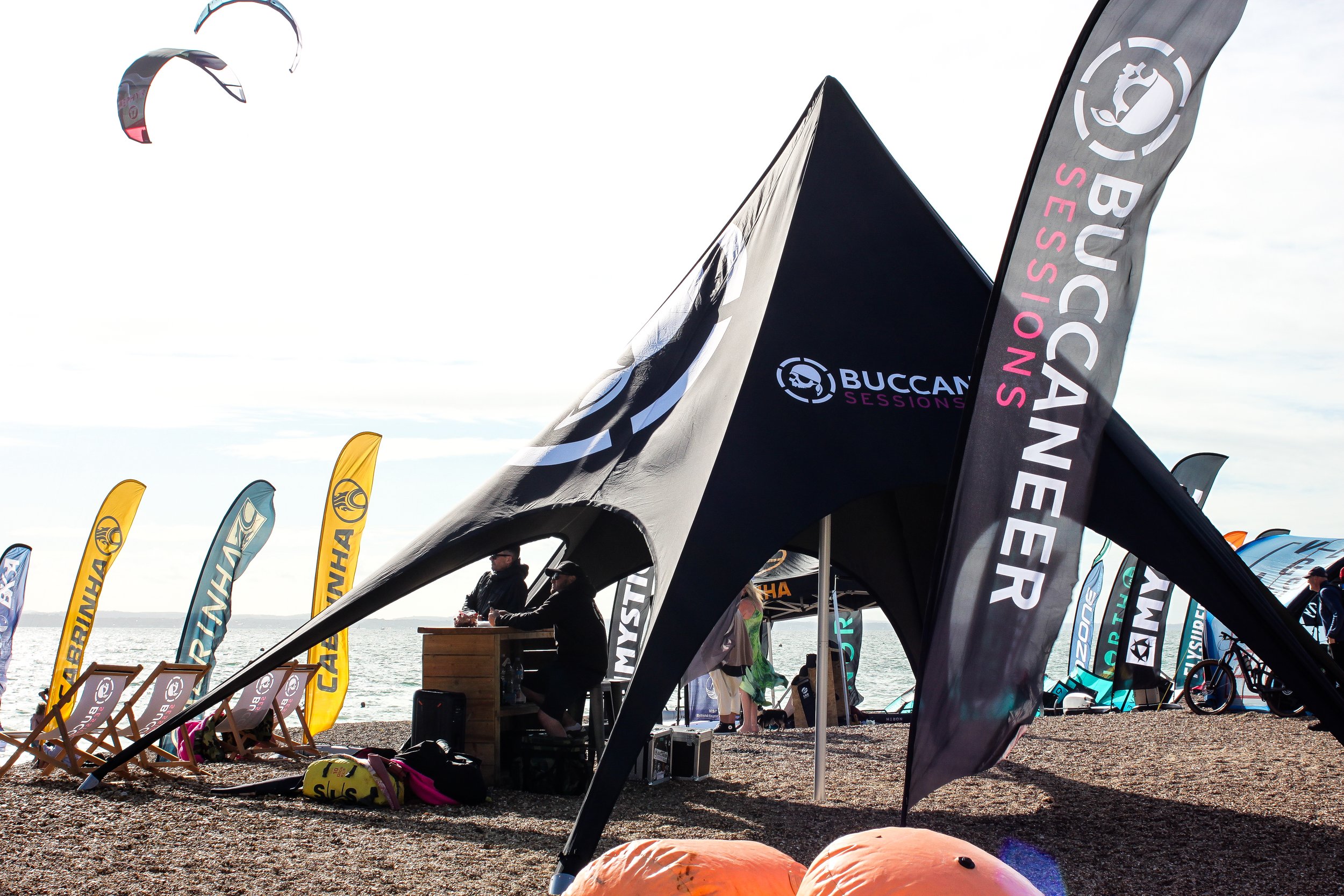
Kitesurfing: Everything You Need to Know to Get Started
Curious about kitesurfing and wondering if it's the right sport for you? You're not alone.
Many newcomers ask, "Is it easy to learn kitesurfing?" or "What are the risks involved?" Kitesurfing, also known as kiteboarding, is an exhilarating water sport that combines elements of surfing, windsurfing, paragliding, and wakeboarding. While it offers an adrenaline rush and a unique sense of freedom, it's important to understand the learning curve, potential risks, and costs involved. Whether you're drawn by the thrill or the community, we'll answer your questions and help you get started on your kitesurfing journey.
Get ready to ride the wind and waves with confidence!
So let’s start at the beginning – If you have heard of Kitesurfing and need some clarity of what it is read on else skip this bit and move on to the next section…
Kitesurfing, also known as kiteboarding, is an extreme water sport that combines aspects of surfing, windsurfing, paragliding, and wakeboarding. It involves using a large, controllable kite to harness the power of the wind, which propels the rider across the water on a small board, similar to a wakeboard or a small surfboard. Here are the main components and features of kitesurfing:
-
The kite is the main propulsion system. It's usually a large inflatable kite or a foil kite, controlled by the rider through a system of lines and a control bar.
-
The control bar is connected to the kite via lines, usually four or five. By manipulating the control bar, the rider can steer the kite and adjust the power it generates.
-
The harness is worn around the rider's waist or hips and is attached to the control bar, allowing the rider to control the kite with their body weight rather than relying solely on arm strength.
-
Kitesurfing requires specific wind and water conditions for safety and enjoyment. Moderate to strong winds are ideal, and flat water or small waves provide the best conditions for riding.
-
There are various styles of kitesurfing, including freeriding (general riding), freestyle (performing tricks), wave riding (surfing waves), and racing. Each style requires different techniques and equipment.
-
Safety is crucial in kitesurfing. Common safety gear includes a helmet, impact vest, and sometimes a wetsuit for cold water. A quick-release system on the control bar allows the rider to disconnect from the kite in an emergency.
Kitesurfing can be an exhilarating sport but requires proper training to handle the equipment and understand the wind and water conditions. Beginners are advised to take lessons from certified instructors to ensure safety and develop the necessary skills.
Download the buccaneer sessions app for free
|
The best kitesurfing spots at your fingertips
|
Download the buccaneer sessions app for free | The best kitesurfing spots at your fingertips |
Why is Kitesurfing so awesome?
Kitesurfing is considered awesome for a multitude of reasons that blend physical, mental, and environmental elements into a thrilling and unique experience. Here’s why it captivates so many enthusiasts:
Kitesurfing is awesome because it combines the thrill of extreme sports with the serenity of nature, providing a comprehensive workout and a mental escape. The sense of freedom, community, and personal achievement it offers makes it a truly unique and captivating activity.
|
Kitesurfing is awesome because it combines the thrill of extreme sports with the serenity of nature, providing a comprehensive workout and a mental escape. The sense of freedom, community, and personal achievement it offers makes it a truly unique and captivating activity. |
Why is kitesurfing so addictive?
Kitesurfing is addictive for numerous reasons.
The release of feel-good chemicals, the positive effects on both mind and body, and the sheer excitement of the ride all play a part in this addiction!
How hard is it to get into kitesurfing?
Getting into kitesurfing can be challenging, but with the right approach and resources, it's achievable for most people. Here are some key factors to consider:
-
Initial Learning: The basics of kitesurfing, such as controlling the kite and understanding wind conditions, can be tricky at first. It typically takes a few lessons to get comfortable with the equipment and safety protocols.
Physical Fitness: While you don't need to be in peak physical condition to start, kitesurfing does require a moderate level of fitness, particularly in your core, arms, and legs.
-
Professional Instruction: Taking lessons from a certified instructor is highly recommended. They provide structured learning, safety training, and hands-on practice.
Lesson Duration: Beginners often need around 6-12 hours of lessons to grasp the basics. This can be spread over a few days or weeks, depending on your schedule.
-
Gear Familiarity: You'll need to become familiar with the kitesurfing gear, including the kite, control bar, harness, and board. Renting equipment initially can be cost-effective and allows you to try different setups.
Safety Gear: Helmets, impact vests, and wetsuits are important for safety and comfort.
-
Wind and Water Conditions: Learning in the right conditions is crucial. Consistent, moderate winds and calm waters make for the best learning environment.
Location: Some places are better suited for beginners due to favorable wind patterns and shallow, obstacle-free waters.
-
Regular Practice: Like any sport, regular practice is key. The more you practice, the quicker you'll progress.
Dealing with Challenges: Expect some falls and frustrations along the way. Patience and perseverance are important.
-
Kitesurfing Community: Joining a kitesurfing club or community can provide support, encouragement, and valuable tips from experienced kitesurfers.
Mentorship: Having a more experienced kitesurfer as a mentor can greatly enhance your learning experience.
-
Cost of Lessons: Professional lessons can be expensive, but they are a worthwhile investment for safety and rapid progress.
Buying Equipment: Once committed, purchasing your own gear is a significant expense but necessary for regular practice.
Getting into kitesurfing involves a blend of physical preparation, proper training, suitable equipment, and the right conditions. With dedication and the right support, most people can learn to kitesurf and enjoy this exhilarating sport.
Is kitesurfing physically hard?
Kitesurfing can be physically demanding, but the level of difficulty depends on several factors, including your fitness level, experience, and the conditions in which you are kitesurfing. Here’s a breakdown of the physical aspects involved:
Core Strength and Stability
Engages Core Muscles: Kitesurfing requires strong core muscles to maintain balance and control the kite. A strong core helps you stabilize your body on the board and manage the forces exerted by the kite.
Improves Balance: The sport demands good balance, especially when navigating through varying wind conditions and water states.
Upper Body and Arm Strength
Kite Control: You use your arms and shoulders extensively to control the kite. The repetitive motion of steering and adjusting the kite can be quite strenuous.
Pulling Power: Launching the kite and keeping it in the air requires significant arm strength, particularly when dealing with gusty winds.
Leg and Lower Body Strength
Board Riding: Standing up on the board and maintaining your position requires strong legs and good balance. Your legs bear the brunt of maintaining stability and steering the board.
Kicking and Manoeuvring: Executing turns and jumps involves explosive movements that engage your leg muscles.
Cardiovascular Fitness
Endurance: Kitesurfing is a full-body workout that can be quite aerobic, especially when riding in challenging conditions. The constant movement and the need to swim back to shore or upwind can be tiring.
Adaptation to Conditions: The need to adapt to changing wind and water conditions can elevate your heart rate and test your endurance.
Flexibility and Coordination
Dynamic Movements: Kitesurfing involves a lot of dynamic movements, requiring flexibility and coordination to handle the kite and board effectively.
Learning Curve: As a beginner, you might find the sport challenging due to the need to learn and integrate various skills quickly.
Safety Considerations
Physical Endurance: Being physically fit enhances your ability to handle falls and exertion, making the sport safer and more enjoyable.
Recovery: The impact from falls and the effort required can lead to muscle soreness, so good physical conditioning helps in recovery and reduces the risk of injury.
While kitesurfing is physically demanding, it is also rewarding and offers a great workout. With regular practice and proper conditioning, most people find that their fitness improves significantly. Whether you're a beginner or an experienced rider, maintaining good physical health and strength is key to enjoying and excelling in kitesurfing.




Just starting out?
DISCOVER OUR TOP SPOTS TO LEARN to kitesurf
want to find out more?
Click on each location to find out more, or read the full blog about our best spots to learn to kitesurf by hitting the button below.
CHECK OUT OUR BLOGS AND ARTICLES THAT feature KITESURFING…
Embark on a journey of limitless possibilities.
Download Buccaneer Sessions Now
Download Buccaneer Sessions today and bring your dreams of surfing, sailing, kiting, riding, and paddling to life!







